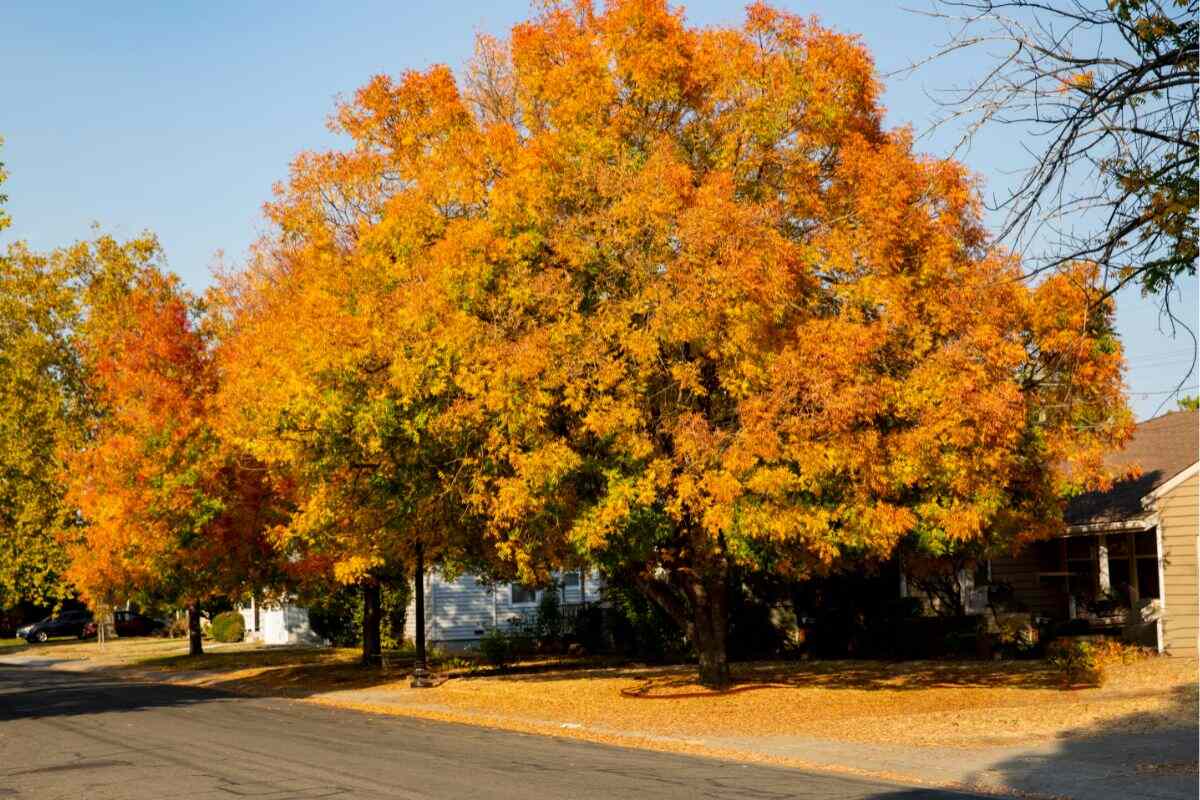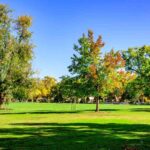
In Sacramento, fall brings cooler temperatures but not a cooling in the intensity of your lawn care. To address your lawn care in Sacramento, CA, during the fall, here are 10 tips from LawnStarter.
Remember, in the fall, Sacramento has to deal with the same issue that drives the rest of the year: the drought conditions. Sacramento entered drought conditions in 2019, remains in them, and is forecast to remain in them, perhaps until 2030.
Sacramento is implementing a series of programs to reduce water usage, and to reward those who do. When you turn to caring for your lawn in the fall, you have to keep in mind that anything you do or want to do will have to call for less water.
1. Adjust Your Watering Schedule
In dealing with the drought conditions, Sacramento has rules for when a home can be watered.
Some forecasters expect California’s drought conditions to last for several years, if not longer. With that in mind, remember this about dealing with water issues:
- Check regularly for changes in regulations for water use.
- Water in the early morning. Say, before 8 a.m.
- Water plants, but not hardscapes.
- When it rains, don’t water. Those automatic sprinklers might not be a good idea (unless you have a rain sensor).
- High winds? Don’t try to water. It is a waste.
- Monitor runoff. If it is more than a trickle, conserve the water.
2. Know When To Mow

The cool-season grasses often used in Sacramento, such as tall fescue, Kentucky bluegrass, and perennial ryegrass, will have a growth spurt in the fall. You will want to mow at least once per week, unless drought conditions are slowing growth.
Follow these guidelines:

- Follow the one-third rule. Don’t cut more than that.
- Keep mower blades sharp. It is simple to do, and dull blades will damage the grass you are trying to develop.
- Mow mid-morning or late afternoon. After the morning dew has burned off but not in the heat of the day.
- Vary your mowing pattern. It keeps the mower from wearing lines in the yard, and catches blades of grass that are missed by going in a particular direction.
- Cut at the proper height for your type of grass.
- Leave your clippings on the lawn
For more information: If you’d love more information on how to care for your Sacramento lawn in spring or summer, check out our other guides below:
You should also review:
3. Dethatch Properly

Thatch is a layer of dead and living grass shoots, stems, and roots that accumulate above the soil and below the green vegetation. A little bit of thatch is normal and even beneficial, but anything over 1/2 inch, and you may need to consider dethatching.
To have a healthy lawn, cool-season grasses such as Kentucky bluegrass should be dethatched in the fall (warm-season grasses in the spring).
The basics of dethatching:
- Dethatch with moist soil but not wet.
- Run the machine three times and in different directions.
- The same amount of material should be churned up each time.
- Remove the piles that were churned up right away.
- Seed the lawn after dethatching it.
Lawn care professionals charge $190 per hour or $250 per 1,000 square feet to dethatch the lawn.
4. Fertilizing Is Key
If you have cool-season grasses (tall fescue, Kentucky bluegrass, and perennial ryegrass are common in Sacramento), you should fertilize them in the fall. Some warm-season grasses (St. Augustinegrass, Bermudagrass, and Zoysia are regularly used in Sacramento) will benefit from being fertilized early in the fall, say in September.
LawnStarter has put together procedures for fertilizing:
How to Apply Granular Lawn Fertilizer
- Use a lawn spreader. Fertilizer spreaders come in different styles, including handheld or one you push from behind.
- Fertilize the perimeter first and work your way inward.
- Water the lawn immediately.
- Clean up. Sweep granules that have fallen on walkways, driveways, or sidewalks back onto the lawn before the rain carries them into the water supply. Wash fertilizer from the spreader; it does have chemicals in it.
How to Apply Liquid Lawn Fertilizer
- Attach or fill your sprayer. Ready-to-spray are common; just attach them to the hose and spray. Some fertilizers call for you to mix them with water and pour them into a sprayer.
- Apply fertilizer evenly as you walk across your lawn. Don’t miss spots and don’t spray more in some places than others; you don’t want a patchy lawn.
- Wait 2-4 hours before watering. If not, you might wash the fertilizer away.
- Clean the sprayer. Use up the fertilizer (pour it out, if you have to) and rinse out the sprayer. Store it away from children and pets.
5. Consider Aerating

Fall is a good time to aerate your soil if you have cool-season grass, such as the ones so common in the area: tall fescue, perennial ryegrass, and Kentucky bluegrass.
The benefits of aerating your lawn:
- Root growth. By lessening soil compaction, water and nutrients can better reach the root zone
- Thatch reduction. Thatch accumulation is removed before it becomes too much.
- Bump removal. It will smooth out a lawn.
- Weed control. A healthy, dense lawn will crowd out weeds.
6. Overseeding Can Be Handy
Overseeding is the process of spreading new grass seed over an existing lawn, usually to fill in bare patches. In the case of places dealing with drought, overseeding can help deal with grass that has turned brown, especially if you mix in a different kind of seed.
Bermudagrass becomes dormant during winter, so a lot of these Bermuda lawns are overseeded, usually with perennial ryegrass. St. Augustinegrass and Zoysiagrass are other warm-season grasses that go dormant in the winter, but they don’t respond as well to overseeding, so few do it.
The steps:
- Dethatch and aerate the lawn, if needed.
- Mow the lawn shorter than usual, down to perhaps an inch. It gives the new seeds better access to the soil.
- Rake after mowing, It removes debris. You also want to scrape up the top of the soil.
- Spread topsoil unless you are using a seed mix that already includes it.
- Spread the grass seed. The package label will tell you how much to use.
- Fertilize the new grass, using a starter fertilizer.
- Water your lawn, but you need only enough water to keep the soil moist.
- Wait to mow or walk on it until it is 2 or more inches tall.
If you have cool-season grass, you can overseed with the same grass in late summer or early fall. This helps to repair bare spots and maintain a full, healthy lawn.
7. It’s Leaf Removal Time
From November through January, the city of Sacramento will pick up leaf collections at your curb. Be sure to check the guidelines each year.
Some tips on leaf removal:
- Remove leaves at least twice, though every 7-10 days is better.
- Start when 25% have fallen. Don’t wait for all of them to fall; they will be decomposing by then and will suffocate your lawn.
- Raking only looks fun. You can twist your back into a painful injury. Go slow.
- Leaf blowers help. You can use them on the dry leaves. The average cost of a leaf blower is $149, a LawnStarter study finds.
- Think compost. Pile up your leaves and add grass clippings. In a few months, they will be compost.
If you’d rather hire a pro, be sure you know what to expect when you hire a leaf removal service.
8. Take the Time to Plan a Major Project
If you want to make a major change in the way you use water in your yard, you might want to replace your traditional lawn with a water-efficient selection of plants and landscaping. But a project to remove your lawn takes planning. Fall can be a good time for homeowners to invest the time to do it the way you want.
- Diagram the yard. Measure things properly (that is, use a tape measure, not your eye). Call 811, a free service that will mark utility lines. Mark slopes and spots with drainage issues.

- Mark the sun and shade. Go out at several points in the day (morning, noon, late afternoon) and mark where the sun is and where the shade falls.

- Dig test holes. These should be two feet deep and will tell you if the soil is compacted, clay, rocky, or sandy.
- Check for rebates. Programs regularly require you to apply before a project is started.
- Decide what you want. Take the time to decide what you want. Trees will last decades. Walls and paths will be difficult to remove … or add later.
- Consider hiring a professional. A yard project can be a do-it-yourself project that will provide a sense of fulfillment. It might also call on skills, equipment, or time that you don’t have. Contact a Sacramento landscaping professional if you’d rather have a pro at the helm.
You can also look into turning a section of your lawn into a garden with the process of sheet mulching. Fall is considered the perfect time of year for it.
9. The Final Mow Before Winter
There is a debate about the final mow before winter. Some say the mowing height should be lower than normal, others say it should be the same as normal.
Arguments in favor of mowing lower than normal:
- It keeps grass from laying over during the winter.
- It can discourage snow mold (a fungus that occurs under the cover of snow).
- There is less growth that needs to be pushed aside by new grass in spring.
- It discourages voles and similar small pests, including rodents. There will be no place to tunnel in your lawn.
- It allows more sun to reach the ground, which leads to warmer soil and an earlier greening in spring.
- It removes dead grass blades and debris.
- Thatch levels are lessened.
Arguments against mowing lower than normal:

- The height is right. The height you have been using all year is there for a reason. You don’t benefit from it being shorter or longer come winter.
- The roots will become smaller if you mow lower, limiting the grass’ ability to take in water and nutrients from the soil.
- Sunlight can reach weeds once the canopy is lower, enabling them to grow more.
10. Review Your Lawn Mower and Other Equipment

Fall is a good time to review the performance of your mower. You can start by looking at the grass blades and grass clippings to determine if the mower blades need to be sharpened.
Should I Get a Different Type of Mower?
Review the size of your yard to decide if you need a different lawn mower:
- Half-acre or smaller: Use a push mower for a lot this size. Home lots are shrinking: Approximately 70% of the lots in America average a quarter-acre or less.
In addition, the average cost for having your lawn mowed is $30 to $65, LawnStarter finds.
- Half-acre to 3 acres: A riding mower will save time and energy.
- Greater than 3 acres: Consider a zero-turn or garden mower. There is better mobility and ease of use.
FAQs
A LawnStarter study has found the following average costs for lawn mowers:
● Average reel mower: $104
● Average walk-behind lawn mower: $363
● Average riding lawn mower: $2,450
● Average robot mower: $1,470
● Average zero-turn mower: $3,284
A LawnStarter study has found the following costs of lawn care:
● Mowing: $30 to $65
● Aeration: $75 to $225
● Dethatching: $190 per hour
● Fertilizing: $20 to $60 per hour
● Winterization: $393
Fall is a good time to address them. You can put down more seed or plant sod, sprigs, or plugs. If you think the spot became bare because of soil problems, mix in fertilizer.
A Call to Action
As you prepare for another decade of drought, it can make a great deal of sense to call in a professional to help you make your decisions for a water-efficient lawn and then to carry them out. LawnStarter can connect you with the Sacramento lawn care service that fits your needs.
You never want to drift into decisions for your yard, especially in this time of water issues. Take the time to make decisions, and then carry them out. You don’t want to have a lawn that dies, or one that requires more maintenance than you want to give. Take action.
Main Image Credit: BWiatre / Canva Pro / License





